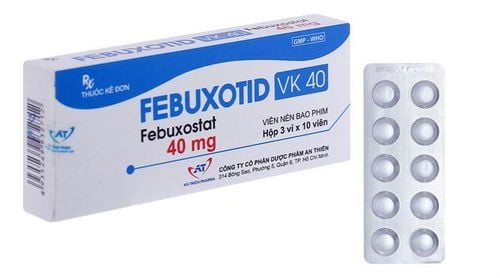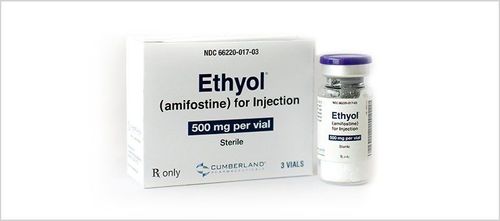This is an automatically translated article.
Aloprim intravenous infusion is commonly used to treat and prevent high serum uric acid caused by anticancer drugs or gout. During the infusion of Aloprim, the patient should strictly follow the instructions of the specialist to prevent side effects.
1. What is Aloprim?
What is Aloprim? Aloprim is a prescription medication given by intravenous infusion that is used primarily to prevent or treat conditions with high levels of uric acid in the blood caused by gout or cancer medications. Aloprim belongs to the class of xanthine oxidase inhibitors, which work by inhibiting the body's production of less uric acid. Aloprim can be used alone or in combination with other medicines under the direct supervision of a doctor.
2. Indications and uses of Aloprim
2.1. Indications for the use of Aloprim Aloprim (allopurinol sodium) is often prescribed by doctors for the following specific cases:
Helps treat hyperuricemia in serum and urine in patients being treated. health conditions such as leukemia, lymphoma, or solid malignancies. Aloprim is given intravenously in patients with high blood uric acid levels who are intolerant to oral medications. Used for the long-term treatment of hyperuricemia caused by chronic gouty arthritis. Treatment of recurrent calcium oxalate stones in men with urinary urate excretion > 750 mg/day and 800 mg/day. 2.2. Uses of Aloprim Aloprim (allopurinol sodium) is the brand name for allopurinol, which acts as a xanthine oxidase inhibitor. Aloprim injection is a sterile solution for intravenous use only. The drug is available in a vial as a sterile lyophilized sodium salt, equivalent to 500 mg of allopurinol. Because Aloprim is used as an infusion, it does not contain preservatives.
Allopurinol sodium has the chemical name 1,5-dihydro-4 H-pyrazolo [3,4- d ]pyrimidine-4-one monosodium salt. It is a white amorphous substance, with a molecular mass of 158.09 and with the molecular formula C 5 H 3 N 4 NaO.
Allopurinol's action is based on purine catabolism, which inhibits biochemical reactions just before its formation, thereby reducing uric acid levels in the blood. Following intravenous administration, allopurinol is rapidly cleared from the systemic circulation through oxidative metabolism to oxypurinol. Approximately 12% of an intravenous dose of allopurinol is excreted unchanged, 76% is excreted as oxypurinol, and the remaining dose is excreted as riboside conjugates in the urine. Oxypurinol is eliminated mainly in the urine as unchanged drug via glomerular filtration and tubular reabsorption, with a net renal clearance of about 30 mL/min.
2.3. In what cases is Aloprim contraindicated? Do not use Aloprim for the following cases:
People with hypersensitivity or allergy to allopurinol. Patient has acute gout. Patients with hyperuricemia alone show no symptoms.
3. Dosage and how to use Aloprim
3.1. Dosage of Aloprim The dose of Aloprim infusion to lower serum uric acid to normal or approximately normal levels will be determined based on the severity of the disease. Doctors can use the patient's serum acid level as an indicator to assess the frequency and amount of taking Aloprim to maintain blood uric acid within normal limits. According to the results of a clinical trial, doses above 600 mg of allopurinol per day in adults do not appear to be more effective. According to the physician's recommendation, the recommended daily dose of Aloprim infusion for children and adults is as follows:
Children: Use a starting dose of Aloprim 200 mg/m 2/day. Adults: Doses of Aloprim from 200-400 mg/m 2/day, up to 600 mg/day. For patients with impaired renal function, the dose of Aloprim should be reduced to avoid accumulation of allopurinol and its metabolites, specifically:
Creatinine clearance 10 - 20 mL/min: 200 mg/day. Creatinine clearance 3 – 10 mL/min: Use 100 mg/day. Creatinine clearance less than 3 mL/min: Prolonged administration of 100 mg/day. 3.2. How to use Aloprim In both children and adults, the daily infusion dose of Aloprim may be given as a single infusion or equally divided into infusions spaced approximately 6, 8 or 12 hours apart with final concentrations not exceeding 6 mg/mL. The Aloprim infusion rate will be based on the volume of infusion. Either way, treatment with Aloprim should be started 24 to 48 hours before the patient starts chemotherapy.
Aloprim infusion should be reconstituted and diluted. Each 30 mL vial of Aloprim should be dissolved with 25 mL sterile water. Reconstituting Aloprim produces a nearly colorless, concentrated solution with a pH between 11.1 and 11.8. Aloprim can be diluted with 5% Dextrose or 0.9% sodium chloride to achieve the ideal concentration.
3.3. What to do in case of an overdose of Aloprim? An overdose of Aloprim can lead to acute poisoning. According to animal studies, the minimum fatal dose of Aloprim was 45 mg/kg intravenously or 500 mg/kg orally. A decrease in activity has been observed with these doses of Aloprim.
Currently there is no specific antidote for overdose of Aloprim infusion. Management of Aloprim overdose is possible through dialysis, however the usefulness of hemodialysis or peritoneal dialysis has not been precisely established.
4. Some side effects of Aloprim
During the infusion of Aloprim, patients may experience some undesirable side effects below:
Skin rash, injection site reactions, urticaria, skin itching. CKD. Nausea or vomiting. Systemic symptoms such as fever, chills, infection, sepsis, hair loss, abdominal distention, pharyngitis, mucositis, cellulitis or hypervolemia. Diarrhea, gastrointestinal bleeding, hepato/splenomegaly, hyperbilirubinemia, jaundice, intestinal obstruction, constipation, flatulence, liver failure, prostatitis. Increased creatinine, hematuria, urinary tract infection, abnormal kidney function. Thrombocytopenia/leukopenia, neutropenia, eosinophilia, anemia, disseminated intravascular coagulation, or bone marrow suppression. Hyperphosphatemia, hypokalemia/calcaemia, metabolic acidosis, lactic acidosis, hyponatremia, water intoxication. Seizures, convulsions, agitation, mood swings, coma, cerebral infarction, muscle paralysis,... Respiratory failure, increased breathing rate or apnea. Tumor lysis syndrome, hypotonia. According to research, the most likely side effect of Aloprim intravenous infusion is a skin rash. Other symptoms may or may not occur, depending on the individual patient. However, if any noticeable reactions are noticed, treatment with Aloprim should be discontinued immediately.
5. Some things to note when using Aloprim
5.1. General notes when using Aloprim For people with a history of allergy to allopurinol or hypersensitivity to the drug, avoid using the drug again when unusual skin reactions have occurred. In addition, patients also need to be careful about the following things during treatment with Aloprim infusion:
Regularly monitor liver, blood and kidney function. People with renal or hepatic impairment should reduce the infusion dose of Aloprim as prescribed by their doctor. Make sure to drink 2-3 liters of water per day to minimize the risk of xanthine deposition in the kidneys. Do not use Aloprim until the acute gout attack has completely subsided. 5.2. Notes on using Aloprim in special populations The following is a doctor's warning about the use of Aloprim with caution in the following special populations:
Pregnant women: Aloprim should only be used when really needed. set. Lactation: Because allopurinol can be distributed into breast milk, caution should be exercised when administering Aloprim to nursing mothers. Although oxypurinol could be found in the infant's plasma, it did not cause adverse effects even though the mother had been on Aloprim for about 6 weeks. Aloprim can cause drowsiness, so drivers and operators should use caution when using.
6. What other drugs does Aloprim interact with?
Below is a list of drugs that can interact with Aloprim when used at the same time, including:
Salicylates and aspirin, which increase blood uric acid levels and reduce the effectiveness of allopurinol . Certain diuretics, alcohol, diazoxide, mecamylamine, or pyrazinamide. Angiotensin-converting enzyme inhibitors cause an increased hypersensitivity reaction (especially in patients with renal impairment). Anti-cancer drugs. Cyclophosphamide co-administration with Aloprim increases the myelosuppressive toxicity of cyclophosphamide. Tamoxifen in combination with Aloprim increases hepatotoxicity. In order to avoid unwanted side effects due to interactions between Aloprim with other drugs, patients need to tell their doctor about all medicines, including health foods that they are taking. Your doctor may recommend a dose adjustment, temporary discontinuation of the medication, or a more suitable alternative.
To ensure effective treatment and avoid unwanted side effects, patients need to strictly follow the instructions of the doctor, professional pharmacist.
Please dial HOTLINE for more information or register for an appointment HERE. Download MyVinmec app to make appointments faster and to manage your bookings easily.
References:/holevn.org, drugs.com













